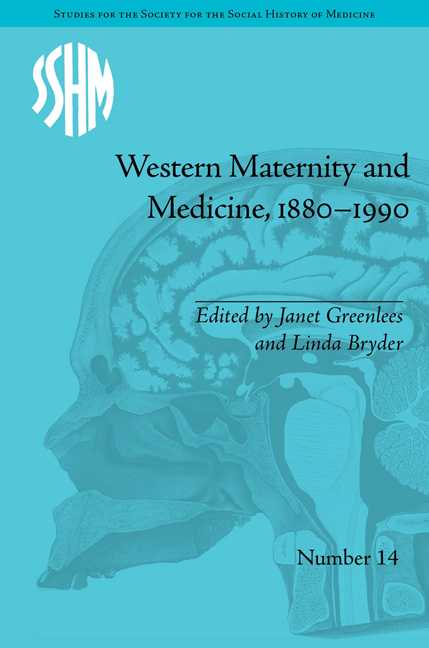Book contents
- Frontmatter
- CONTENTS
- Acknowledgements
- List of Contributors
- List of Tables
- Western Maternity and Medicine: An Introduction
- 1 Safely Delivered? Insights into Late Nineteenth-Century Australian Maternity Care from Coronial Investigations into Maternal Deaths
- 2 Pregnancy, Pathology and Public Morals: Making Antenatal Care in Edinburgh around 1900
- 3 ‘The Peculiar and Complex Female Problem’: The Church of Scotland and Health Care for Unwed Mothers, 1900–1948
- 4 Taking ‘Advantage of the Facilities and Comforts … Offered’: Women's Choice of Hospital Delivery in Interwar Edinburgh
- 5 ‘What Women Want’: Childbirth Services and Women's Activism in New Zealand, 1900–1960
- 6 'Twixt God and Geography: The Development of Maternity Services in Twentieth-Century Ireland
- 7 Test Tubes and Turpitude: Medical Responses to the Infertile Patient in Mid-Twentieth-Century Scotland
- 8 Women's Experiences of the Maternity Services in Berkshire and Oxfordshire, c. 1970–1990
- 9 From Muller to Johnson Controls: Mothers and Workplace Health in the US, from Protective Labour Legislation to Fetal Protection Policies
- Notes
- Index
Western Maternity and Medicine: An Introduction
- Frontmatter
- CONTENTS
- Acknowledgements
- List of Contributors
- List of Tables
- Western Maternity and Medicine: An Introduction
- 1 Safely Delivered? Insights into Late Nineteenth-Century Australian Maternity Care from Coronial Investigations into Maternal Deaths
- 2 Pregnancy, Pathology and Public Morals: Making Antenatal Care in Edinburgh around 1900
- 3 ‘The Peculiar and Complex Female Problem’: The Church of Scotland and Health Care for Unwed Mothers, 1900–1948
- 4 Taking ‘Advantage of the Facilities and Comforts … Offered’: Women's Choice of Hospital Delivery in Interwar Edinburgh
- 5 ‘What Women Want’: Childbirth Services and Women's Activism in New Zealand, 1900–1960
- 6 'Twixt God and Geography: The Development of Maternity Services in Twentieth-Century Ireland
- 7 Test Tubes and Turpitude: Medical Responses to the Infertile Patient in Mid-Twentieth-Century Scotland
- 8 Women's Experiences of the Maternity Services in Berkshire and Oxfordshire, c. 1970–1990
- 9 From Muller to Johnson Controls: Mothers and Workplace Health in the US, from Protective Labour Legislation to Fetal Protection Policies
- Notes
- Index
Summary
The period 1880–1990 saw dramatic transformations in women's experiences of pregnancy and childbirth in the Western world. The most prominent was the change of location of childbirth, from the home to the hospital. This era also saw the establishment and public acceptance of scientific medicine in Western society, including infertility, antenatal and childbirth services. In the twentieth century the health of mothers as well as their newborn babies became the subject of much political and public concern and attention. From the 1930s, there was a steep and constant decline in maternal mortality and later in perinatal mortality. The relationship between all these changes has been the subject of immense historical analysis, with authors adopting very different perspectives, and the ways in which the narrative has been told has altered markedly in line with the wider social and cultural changes of the late twentieth century. Much of the writing from the 1970s came from a feminist political perspective. The vast expansion of the discipline of the history of medicine over subsequent decades has seen others enter the field from a less ideological perspective. The authors of this volume fall into the latter category. Whilst drawing on that earlier literature (outlined below), these essays offer fresh perspectives, contributing to a broader, more nuanced understanding of the cultural, social and political history of pregnancy and childbirth in the modern Western world.
- Type
- Chapter
- Information
- Western Maternity and Medicine, 1880–1990 , pp. 1 - 12Publisher: Pickering & ChattoFirst published in: 2014



